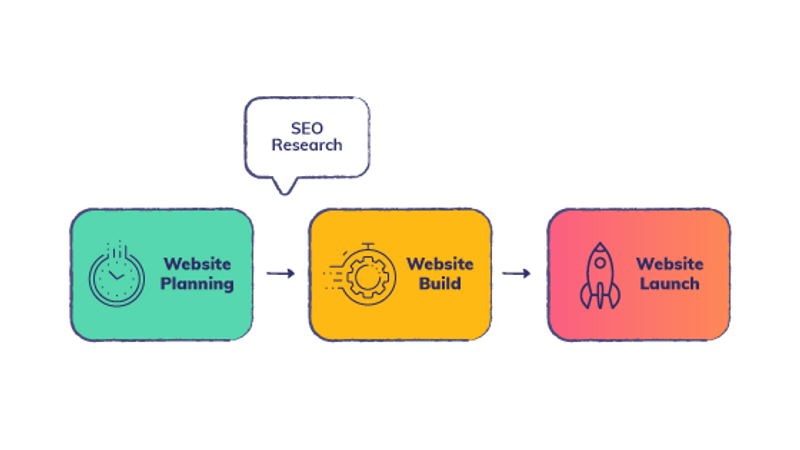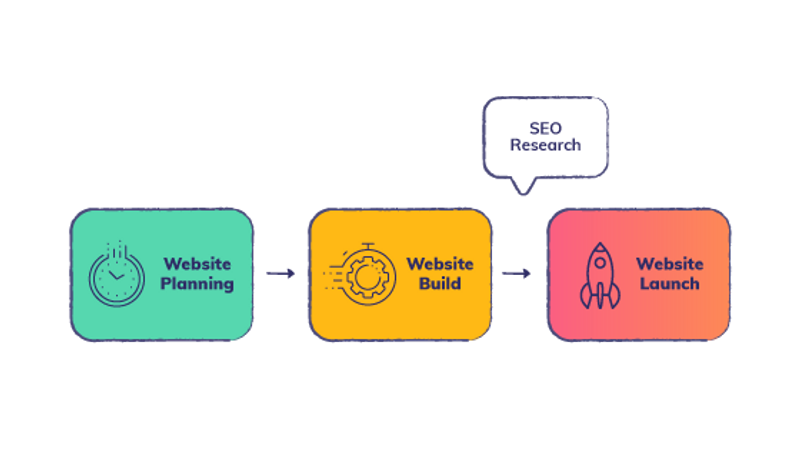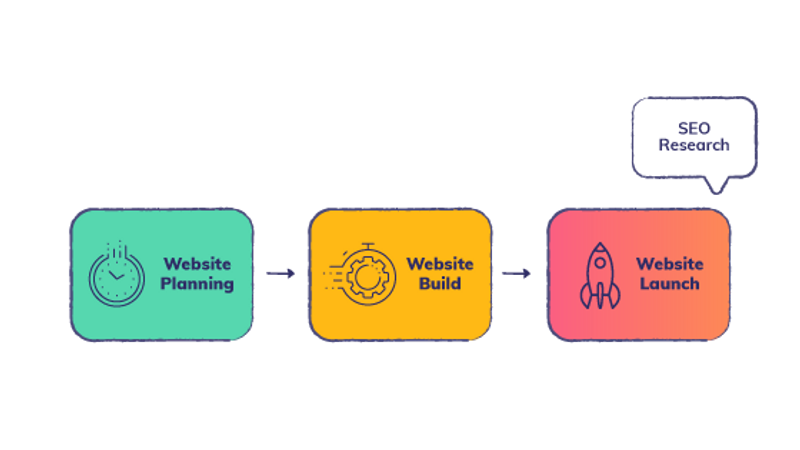When it comes to website design and SEO, many business owners and marketing managers approach the situation backwards. Usually, the thought process is something like:
“Alright, got the new site launched…finally! Now let’s get some SEO done so we can start getting that organic traffic flooding in!”
The sequence of this thinking makes sense intuitively, and there are situations where this approach can work (more on that later). However, if your business depends on organic visibility to drive any meaningful amount of revenue, you likely want to approach the process differently:
“Organic traffic is important to my business, so I should invest in the proper research before building my website so I know what pages I need to build, and how I should build them.”
If you are starting a new business, there may even be situations where investing in preliminary research can inform whether or not the business as a whole is viable.
For example, if you woke up from a 20-year coma and decided to launch a blog all about the benefits of dial-up internet, doing a little keyword research first would quickly invalidate this idea. (Author’s note: although, if I came across an article titled “How to Get Your Mom off the Phone to Check Your Hotmail,” I’d probably click…)
Here at Flyrise, we are making great marketing attainable for even small and midsize businesses. To do this, we are very heavily invested in our systems. So naturally, we’ve spent a lot of time working out how to systemize the SEO process for new websites that we build…
…And website design and SEO has been perhaps the most challenging thing for us to systemize effectively.
Why? Because the relationship between SEO, new website builds or website redesign projects and project planning varies on a case-by-case basis if you are truly doing it right.
To illustrate this idea, we are going to expand on the examples mentioned above. Before we get into that though, we’re going to go over the questions to be thinking about to help you determine where SEO fits into the process of your new website or website redesign SEO plan.
Website SEO Questions to Ask

“How do I plan to make money from my website?”
Having a good understanding of how your website makes money will help you determine how SEO fits into the picture. On one end of the spectrum, you have business models where organic visibility drives nearly 100% of revenue. Others have a very obscure niche product and only need a website for existing customers or new referrals to navigate effectively.
In general, the more financial emphasis you place on organic discovery of your business, the earlier you want to consider investing in SEO as part of your website design and SEO planning process.
“How much SEO opportunity is actually out there for me?”
Understanding how much SEO opportunity is out there will help you understand not only how much to invest in SEO (and your website), but also when and how to invest. If you discover that there are 100,000 searches a month for your main keyword, that demands a much different approach than a keyword getting 10 searches per month. Don’t forget to consider content-driven keywords as well. When Jennifer Fitzgerald started PolicyGenius, nobody was searching to buy insurance online yet. However, she and her partner had the foresight to produce a ton of great content around insurance-related questions, as those were getting searched.
The less certain you are about how your customers are using search engines to discover your offerings, the earlier you want to consider investing in SEO research to support your new website or website redesign process.
“Are my products and services flexible enough to align with that opportunity?”
Do you have the ability to adjust your products and services based on what people are searching for? Or do you just have one or two niche products that are defined and unchanging? Are there additional ways you can monetize your business and expertise even if your products are defined, like with an online training course or referral programs with businesses selling complimentary products?
As a rule of thumb, the more flexible your offerings and the more creative you can be with your monetization ideas, the earlier you want to consider SEO in the process of building your new website.
“How competitive is my niche?”
This question is the sister question to the one above on SEO opportunity. Obviously, if a keyword gets 100,000 searches a month and is very easy to rank for, that will strengthen your case to invest in the right type of website and marketing strategy to rank for it. On the other hand, if your keywords only get 100 searches a month and the search landscape is super competitive, you may want to adjust your website strategy to focus more on building landing pages and funnels, knowing that you’ll likely be generating business growth from your website through Google Ads and other paid advertising methods.
As a benchmark, the less understanding you have around your SEO competition, the earlier you want to consider investing in SEO before diving into your website build.
“How do my customers use search?”
Search intent is very important and usually isn’t given enough attention as it deserves. Ranking for keywords means nothing if those keywords don’t lead to organic traffic that converts into revenue for your business. Understanding if your customers use search just to quickly or lazily access your site (navigational intent) vs. if they are using search just to find answers to their questions (informational intent) vs. if they are using search to make buying decisions (transactional or commercial investigation intent) will help you determine how valuable your search traffic actually will be.
The more your business’ website content and offerings align with the search intent of your customers, the more important SEO research is to your planning process, and the earlier it should be incorporated into the mix.
“What is my website and marketing budget overall?”
Last but not least, there’s a consideration to be made for the size of your website budget and marketing budget overall. While SEO research can vary by industry and business, there are parameters your initial cash investment will stay between. For example, if you have $20,000 to build your website, and a monthly marketing budget of $3,000 after you launch, it will likely make sense to pay 5-10% of your website budget for SEO research up front just to ensure you get the most value out of the rest of your website investment – even if you’re a business that doesn’t need a lot of SEO focus to your website.
The more money you plan to invest on your website and marketing plan, or simply the bigger and more established your business is, the more it makes sense to invest in SEO earlier in the website build process rather than later.

- If your business is fairly well-established, and your website serves a meaningful role in your operation, investing in SEO research before you start your build is the safe, smart play.
New Website SEO: Different Approaches
Now that you have an idea of the questions you should be considering, we’re ready to get into four different website SEO strategies you can deploy as you map your business’ course for world domination!
It should be noted though that any SEO purist will likely tell you that no matter the case, SEO research should be done as early as possible, usually before the website project is even bid out (see Strategy #1 below).
While this may be true in a technical sense, we work with a lot of small and midsize businesses who may not be able to afford extensive discovery work when there’s a very good chance it isn’t entirely necessary.
Please consider the strategies below as our own unique blend of academic understanding with practical application that many of our clients need to maximize their marketing budgets!
Website Design SEO Strategy #1
Doing SEO Research Before You Even Decide to Build the Site

This website SEO strategy makes the most sense when:
- You aren’t sure if it makes sense to build a new website or redesign an old one
- You aren’t sure what type of budget you need to build a website that meets your goals
- You have flexibility in your products, services or monetization strategies to let SEO opportunity fully inform if and how you build your site
Example: An outdoor enthusiast is debating whether or not to turn her passion for nature into an outdoor lifestyle blog. This blog would generate revenue through affiliate marketing and display advertising and would be heavily dependent on organic traffic. Investing in deeper SEO research upfront will help her understand the SEO landscape better, which will in turn help with budgeting for the initial website and marketing strategy, while also shining light on a realistic road to profitability. If the enthusiast builds out the website first, she may find out later that the site she built was not up to snuff from an SEO standpoint, or that the market was too competitive and her runway was too short to make this a viable business.
Website Design SEO Strategy #2
Doing SEO Research After Your Initial Sitemap

This website SEO strategy makes the most sense when:
- You know you want to build a new website or redesign an old one
- You aren’t sure what type of budget you need to build a website that meets your goals
- You have limited flexibility in your products, services or monetization strategies to let SEO opportunity somewhat inform if and how you build your site
Example: A retailer specializing in hot tubs and saunas knows they need to update their website, and knows they need pages for categories like “hot tubs” and “saunas.” but isn’t sure if it makes sense to expand their website to include subcategory pages like “hot tub filters.” An initial website is built based on their non-negotiable products and services, but there is a shared understanding with their web and SEO team that the scope may expand (or contract) based on their findings before officially moving from the planning phase into the design phase for the new website.
Website Design SEO Strategy #3
Doing SEO Research As Part the Web Design and Copywriting Process

This website SEO strategy makes the most sense when:
- You know you want to build a new website or redesign an old one
- You are familiar with the SEO landscape for your business and understand that SEO isn’t a big need for you
- You may or may not have a fixed budget, but the budget is determined by other factors not related to SEO
- You have limited flexibility in your products, services or monetization strategies, and because SEO is a small part of your strategy, you simply want to squeeze as much SEO juice from your new website as possible as long as it aligns with the way you want to build your site naturally.
Example: A niche wholesale business knows there isn’t much organic search opportunity out there. However, they at least want to make sure they are discoverable for the few people that do search for their offerings. A small budget for keyword research is allocated during the copywriting process to make sure no easy opportunities are missed, and a modest budget is also earmarked for other basic website SEO opportunities, like SEO titles and meta descriptions, image alt tags, and other website design and SEO considerations.
Website Design SEO Strategy #4
Doing SEO After the New Site is Launched

This website SEO strategy makes the most sense when:
- You know you want to build a new website or redesign an old one
- You are familiar with the SEO landscape for your business and understand that SEO isn’t a big need for you
- You may or may not have a fixed budget, but the budget is determined by other factors not related to SEO
- You have limited flexibility in your products, services or monetization strategies, and because SEO is a small part of your strategy, you simply want to squeeze as much SEO juice from your new website as possible as long as it aligns with the way you want to build your site naturally.
Example: A local storage unit in a small town knew that they had virtually no competition for their keywords, and the search intent was fully aligned with how their web pages would be anyway. “Storage units Camas WA” is about as straightforward as it gets from an SEO standpoint. Additionally, the website budget was very limited and given the situation, a quick run-through post-launch to tweak a few SEO titles and meta descriptions, headings, and URLs proved enough to do the trick after 6 months.
Need Help with Web Design or Website Redesign SEO Planning?
Hopefully, you have been able to place yourself in one or two of the four categories above. If you’re still unsure, we’re here to help! Our team of marketing experts has experience in working with all types of different website projects across the four strategies outlined above. We’ll help you make the right next steps!
To find out where SEO considerations fall in line with your new website or website redesign project, or to throw up a flair if you’ve already built your new site and need to figure out how to work backward with your SEO plan, click here to schedule a complimentary discovery call with our marketing experts.
